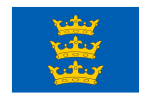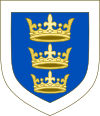Lordship of Ireland
|
Lordship of Ireland 1171–1541 |
|||||
|---|---|---|---|---|---|
|
|||||
|
|||||
| language | Irish , English , Anglo- Norman | ||||
| Capital | Dublin | ||||
| Form of government | monarchy | ||||
| Head of state | lord | ||||
| Existence period | 1171-1541 | ||||
The Lordship of Ireland ( English Lordship of Ireland , Irish Tiarnas na hÉireann , 1171 to 1541 ) was nominally an island-encompassing Irish state as a result of the Anglo-Norman conquest from 1169. Despite this fact, the rulership of the state, in addition to some Anglo-Norman strongholds, remained on a small area restricted to Dublin - an area later named The Pale .
origin
The origin of the lordship lies in the decision of Diarmuid MacMorroughs , a prince from Leinster , to ask the Norman warrior Richard de Clare (aka Strongbow) for help to regain his throne, which MacMorrough had lost to a confederation under the new Irish high king. Henry II , ruler over England and parts of France , then planned an invasion of Ireland to keep de Clare under control, whom he saw as a threat to the stability of his own kingdom; for there was fear in England since the 10th century that Anglo-Saxon refugees could use Ireland or Flanders as a base for an attack on England.
Another reason for Henry II's invasion was a bull from Pope Hadrian IV that allowed the English monarch to occupy Ireland. At that time Ireland was still characterized by a Celtic-Christian faith that was largely independent of the Catholic Church. By invading Henry, the Pope wanted to incorporate this church into the Roman Catholic Church. The Pope traced back the right to distribute sovereignty to monarchs over different islands to a document known as the Donation of Constantine . So he bequeathed Ireland to the English monarch as a feudal area under the suzerainty of the Pope. This bull made the English king Lord of Ireland . After conquering a small part of Ireland's east coast, Henry used the land to settle a dispute within his family. Heinrich had divided his territory among his sons, only his son Johann (English: John Lackland ) had not yet received any territory; hence its nickname Johann Ohneland . Heinrich now bequeathed Ireland to his son Johann, who thus became Lord of Ireland ( Dominus Hiberniae ) in 1185 . The conquered part of Ireland thus formed the Lordship of Ireland.
Fate, however, resulted in the deaths of Johann's older brothers. John thereby became King of England and the Lordship of Ireland became a territorial part of the English crown instead of a separate area ruled by a minor English prince. English monarchs continued to use the title of Lord of Ireland to support their claim to the island of Ireland .
In the course of the 14th and 15th centuries, however, the political and cultural rule of the English was limited to the increasingly narrow coastal strips around Dublin, Wexford and enclaves in Northern Ireland . The rest of the island remained dominated by Irish rulers, who for the most part practiced local customs , upheld the Brehon Laws and spoke Irish .
In 1541 the title was by the Act of the Irish Parliament in King of Ireland ( King of Ireland ), and the name of the State in Ireland Kingdom ( Kingdom of Ireland ) changed. This happened at the urging of Henry VIII , because the title of Lord of Ireland was originally granted to the English king by the Pope and Henry VIII had been excommunicated by the Catholic Church , so that the title was no longer valid.
See also
literature
- A New History of Ireland. Edited by FJ Byrne et al. 9 volumes. Oxford University Press, Oxford u. a. 1976 ff.
- James Camlin Beckett: History of Ireland. 3. Edition. Kröner, Stuttgart 1991, ISBN 3-520-41903-3 .
- Clare Downham: Medieval Ireland. Cambridge University Press, Cambridge 2018.
- Peter Harbison , Michael Richter : Ireland. In: Reallexikon der Germanischen Altertumskunde (RGA). 2nd Edition. Volume 15, Walter de Gruyter, Berlin / New York 2000, ISBN 3-11-016649-6 , pp. 494-504.
- Seán Duffy (Ed.): Medieval Ireland: An Encyclopedia. Routledge, London / New York 2004, ISBN 978-1-135-94824-5


